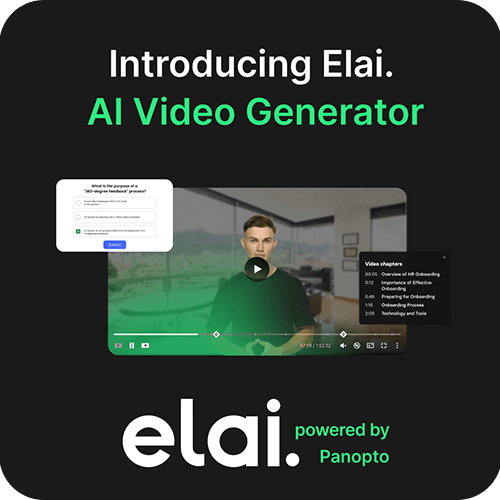- Events
4 Key Takeaways from Panopto Innovate Southeast

This October, we got together at the Panopto Innovate User Conference Southeast at Duke University. User Groups are popular in the Panopto community as they empower our thought leaders from higher education institutions to share best practices, give feedback, and discuss how to enhance the overall teaching and learning experience. It’s also a perfect time to see how others are using Panopto in their classrooms,
Throughout the day, we kept discussing lecture capture, accessibility, the best audio and video equipment, and streamlining platform administration. The star of the Panopto Innovate Conference was our host, Duke University. Duke, with its 14 years of experience using Panopto, showed us how it’s fine-tuned its automated lecture capture workflows, LMS integrations, and administrative tasks to save time, make things easier for students, and give its faculty more freedom.
Read on for four key takeaways from the conference.
1. Standardized Lecture Capture
Todd Stabley, Duke’s Senior Media Engineer, shared how they’ve made recording classes the norm around campus. Stabley outlined that “automated class recording with Panopto is our top use case.” Manually scheduling and managing class recordings projected to surpass 28,000 could become unsustainable, and for Stabley and his peers at Duke, the ‘opt-in’ model left room for questions from both teachers and technicians.
It’s for this reason that Duke made class recordings a campus-wide standard. Affectionately dubbed “class DVR”, faculty members now need to submit ‘opt-out’ forms to prevent scheduled session recordings. This is not only for the sake of streamlining and for students who may not be able to attend classes, but it also ensures an equitable learning experience for students who may have accessibility requirements such as captioning.
2. Refining Teaching Methods
With class DVR in place, instructors can really focus on improving their teaching methods. These tools allow instructors to track how students interact with video content, pinpointing which segments are most revisited and where engagement might dip. By understanding these patterns, teachers can adjust their lessons to better meet students’ needs, clarify complex topics, and amplify engaging content. This data-driven approach not only enhances student learning but also encourages educators to innovate continuously in their teaching methods.
Through their streamlined enterprise IT management model and close collaboration with Panopto and other partners, Duke can more freely experiment with and evaluate their technical systems and pedagogy. As Stabley summarizes, “We really feel Panopto as a vendor has worked closely with us, and we’re continuing to evolve and develop together.”
“We really feel Panopto as a vendor has worked closely with us, and we’re continuing to evolve and develop together.”
Todd Stabley, Senior Media Engineer, Duke University
3. Delegated Access Standards
Jacob Tjalma, Site Administrator of Duke University Fuqua School of Business, shared details of how Duke approaches controlling who has access to video content, and the duration of those access rights. While the Fuqua School of Business takes an opt-out approach to class recording, most of the rest of the university is officially opt-in. This approach allows for flexibility and ensures that the specific needs of different departments are met.
The Fuqua Ford Library staff at Duke needed granular control over the access and distribution of video content because academic fair use copyright restrictions may dictate the start and end dates for any individual video’s viewing access.
Because of this, Duke granted creator-level access to library staff, enabling them to directly control any video’s access standards using Panopto’s release/lapse feature. By letting library staff control video access times, they avoid a lot of back-and-forth with administrators, making sure videos meet fair-use rules without hassle. This approach reduces administrative bottlenecks, allowing staff to be more responsive and efficient in managing content access.
4. Automated Maintenance
Gurpreet Hothi, from OIT Academic, User & Device Support, shared insights on how Duke approaches configuring its hardware and software. This includes practical use cases exploring hardware longevity and reusability alongside specific client configurations that grant ease of access to OIT and site administrators.
Hothi also elaborated on Duke’s approach to hardware and software maintenance. Through their meticulous testing and annual software/hardware update scheduling, over 95% of Duke’s active devices are updated or upgraded within two days during the break between the Spring and Summer semesters.
Through Duke’s campus-wide minimization of variety in software and hardware, OIT and the site administrators could streamline and automate most of their maintenance-related responsibilities, thereby minimizing downtime and freeing up more time to innovate and experiment with new solutions.
We wrapped up the conference with a tour of Duke’s beautiful campus and their classroom audio and video technology, plus we were able to see their e-learning production studios. A big thank you to Duke for hosting Panopto Innovate Southeast and to everyone who attended. The conversations were really insightful, and we are looking forward to engaging with more of our community at our upcoming User Conference at UCLA on December 9th.
Investing in Our Customers
Panopto is dedicated to ensuring our customers’ success. As a market leader serving more than 11 million active users worldwide, we focus on delivering the best customer experience for our higher education customers and their communities. Our investment in technology support, training, and products allows us to deliver a best-in-class, future-ready product for our higher education customers.
If your institution would be interested in hosting or attending a user group, please don’t hesitate to enquire at: marketing@panopto.com.
Latest News
-

- Generative AI
Fact or Myth: Can AI Replace Salespeople?
Artificial intelligence is transforming industries at an unprecedented rate, and AI in sales is no exception. With AI-powered chatbots, AI sales assistants, and automated outreach tools gaining traction, businesses increasingly rely on technology to handle customer interactions. But does this mean that AI can replace human salespeople? Or is this just another tech myth? In…
Fact or Myth: Can AI Replace Salespeople?
-

- Learning and Development
Mastering the Competency Mapping Process
A well-structured competency mapping process is essential for building a high-performing workforce. Businesses that understand their employees’ skills, strengths, and development areas can make smarter hiring decisions, create effective training programs, and align talent with business goals. Without a clear framework for identifying and assessing competencies, organizations risk skill gaps, inefficiencies, and missed growth opportunities….
Mastering the Competency Mapping Process
-

- Presentations
How to Use a PowerPoint Screen Recorder to Capture Presentations on Video
A PowerPoint screen recorder has become an indispensable tool for professionals who want to transform static presentations into dynamic, shareable video experiences. Gone are the days when compelling presentations were confined to conference rooms or live webinars. Today’s knowledge workers need versatile ways to capture, share, and preserve their insights. Whether you’re an educator bridging…
How to Use a PowerPoint Screen Recorder to Capture Presentations on Video



